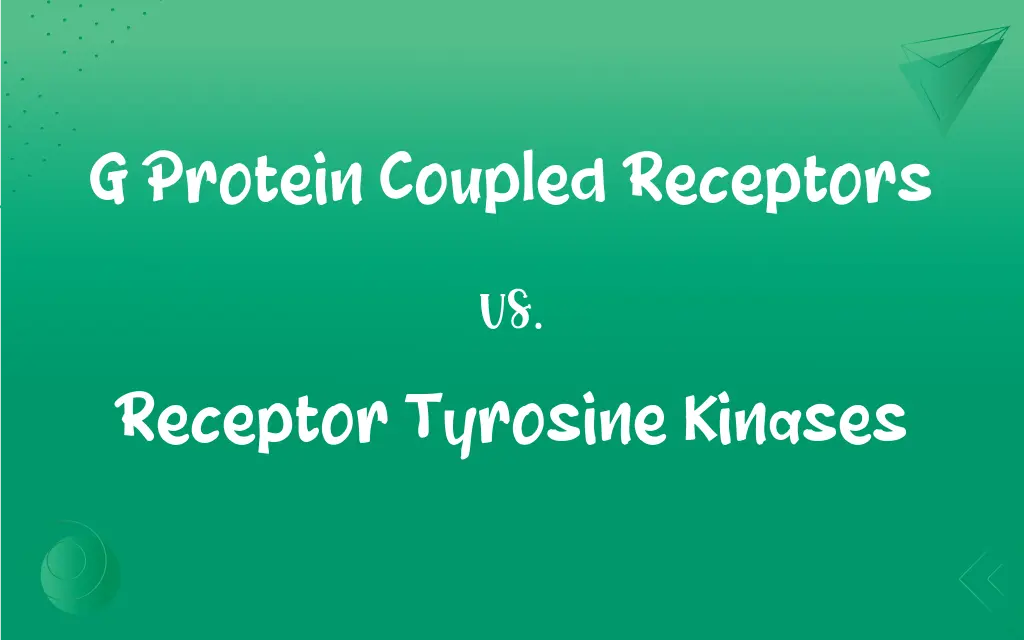G Protein Coupled Receptors vs. Receptor Tyrosine Kinases: What's the Difference?
Edited by Harlon Moss || By Janet White || Published on February 8, 2024
G protein-coupled receptors (GPCRs) activate G proteins, affecting cellular responses; receptor tyrosine kinases (RTKs) phosphorylate tyrosines on target proteins, influencing cell growth and differentiation.

Key Differences
G protein-coupled receptors (GPCRs) are characterized by their seven transmembrane helices. They activate G proteins, which in turn modulate various intracellular signaling pathways. Receptor tyrosine kinases (RTKs), however, are single-pass transmembrane proteins that, upon ligand binding, dimerize and activate their intrinsic kinase activity to phosphorylate tyrosine residues on target proteins.
In GPCRs, the receptor's interaction with a ligand causes a conformational change, allowing it to activate G proteins. This activation can trigger multiple downstream signaling cascades. RTKs, once activated through dimerization, phosphorylate specific tyrosine residues on themselves and other proteins, directly triggering specific signaling pathways related to cell growth, survival, and differentiation.
GPCRs play a vital role in various physiological processes, including sensory perception, neurotransmission, and immune responses. RTKs are crucial in regulating cell division, growth, and development, and their dysfunction is often implicated in cancer.
Examples of GPCRs include adrenergic receptors and olfactory receptors. RTKs include the epidermal growth factor receptor (EGFR) and insulin receptor. Both receptor types are significant targets in drug development, with GPCRs being the target for many drugs for various conditions, and RTKs being targeted in cancer therapies.
GPCRs can be rapidly desensitized and internalized, allowing cells to quickly adapt to continuous stimulation. RTKs, through their kinase activity, can create more sustained responses and are regulated by mechanisms like endocytosis and degradation.
ADVERTISEMENT
Comparison Chart
Structure
Seven transmembrane helices
Single-pass transmembrane proteins
Signaling Mechanism
Activate G proteins, triggering signaling cascades
Phosphorylate tyrosines, initiating specific pathways
Physiological Role
Diverse, including sensory perception, neurotransmission
Cell growth, differentiation, often implicated in cancer
Key Examples
Adrenergic receptors, olfactory receptors
Epidermal growth factor receptor, insulin receptor
Clinical Relevance
Targeted by various drugs for multiple conditions
Targeted in cancer therapy
ADVERTISEMENT
Regulation and Adaptation
Rapid desensitization and internalization
Regulated by endocytosis, degradation
G Protein Coupled Receptors and Receptor Tyrosine Kinases Definitions
G Protein Coupled Receptors
Can rapidly adapt to continuous stimulation.
Continuous exposure to a certain smell can desensitize nasal GPCRs.
Receptor Tyrosine Kinases
Involved in cell growth and differentiation.
Dysregulation of certain RTKs can lead to cancer development.
G Protein Coupled Receptors
Major drug targets in pharmacology.
Many antihistamines target histamine GPCRs to alleviate allergy symptoms.
Receptor Tyrosine Kinases
Can create sustained cellular responses.
Activation of RTKs can trigger long-term changes in cell behavior.
G Protein Coupled Receptors
Receptors that activate G proteins in response to ligands.
The beta-adrenergic receptor, a GPCR, mediates the response to adrenaline.
Receptor Tyrosine Kinases
Phosphorylate tyrosine residues on target proteins.
Insulin receptor, a RTK, helps regulate glucose levels in the body.
G Protein Coupled Receptors
Characterized by seven transmembrane domains.
GPCRs like the rhodopsin in the eye are crucial for vision.
Receptor Tyrosine Kinases
Targeted in cancer therapy.
Drugs targeting the HER2 RTK are used in some breast cancer treatments.
G Protein Coupled Receptors
Involved in diverse physiological processes.
GPCRs in the nose are responsible for detecting various odors.
Receptor Tyrosine Kinases
Transmembrane receptors with intrinsic kinase activity.
The EGFR is a RTK that plays a role in cell growth.
FAQs
Can GPCRs be targeted by drugs?
Yes, they are major targets for various medications, including heart disease and allergies.
What are G protein-coupled receptors?
Membrane receptors that activate G proteins in response to external stimuli.
What function do receptor tyrosine kinases serve?
They phosphorylate tyrosine residues, influencing cell growth and differentiation.
How are GPCRs involved in sensory perception?
They detect external signals like odors and light, triggering sensory responses.
Is the structure of GPCRs and RTKs similar?
No, GPCRs have seven transmembrane domains, while RTKs are single-pass transmembrane proteins.
What role do RTKs play in cancer?
Overactive RTKs can lead to uncontrolled cell growth, contributing to cancer.
Are RTKs important in developmental biology?
Yes, they are crucial in cell growth and development processes.
How do GPCRs adapt to continuous stimulation?
They can be desensitized or internalized to reduce responsiveness.
How are RTKs regulated?
Through mechanisms like endocytosis and degradation.
How do mutations in RTKs affect the body?
Mutations can lead to disorders like cancer due to uncontrolled signaling.
Are GPCRs and RTKs involved in heart disease?
GPCRs are involved, especially in heart rate regulation; RTKs less so in heart disease.
What types of diseases involve RTK dysfunction?
Primarily cancers, due to their role in cell growth and division.
How do GPCRs activate G proteins?
Through conformational changes upon ligand binding, which then interact with G proteins.
What happens when RTKs are activated?
They dimerize and phosphorylate tyrosine residues, initiating signaling pathways.
Can GPCRs affect the immune system?
Yes, they are involved in various immune responses.
Can GPCRs be found in all types of cells?
They are widely distributed in many cell types, involved in numerous functions.
What therapies target RTKs?
Targeted therapies in cancer treatment, like tyrosine kinase inhibitors.
Do GPCRs have a role in drug discovery?
Yes, they are significant targets in the development of new drugs.
Are GPCRs involved in neurotransmission?
Yes, they play key roles in transmitting neural signals.
What is the clinical significance of RTKs?
They are targets for cancer therapies due to their role in cell proliferation.
About Author
Written by
Janet WhiteJanet White has been an esteemed writer and blogger for Difference Wiki. Holding a Master's degree in Science and Medical Journalism from the prestigious Boston University, she has consistently demonstrated her expertise and passion for her field. When she's not immersed in her work, Janet relishes her time exercising, delving into a good book, and cherishing moments with friends and family.
Edited by
Harlon MossHarlon is a seasoned quality moderator and accomplished content writer for Difference Wiki. An alumnus of the prestigious University of California, he earned his degree in Computer Science. Leveraging his academic background, Harlon brings a meticulous and informed perspective to his work, ensuring content accuracy and excellence.































































